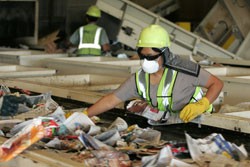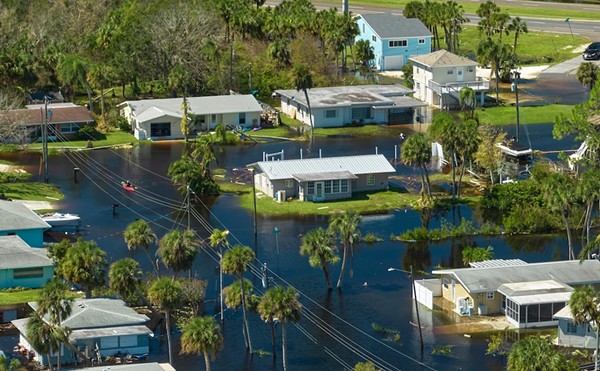Even on a dreary, sunless day, Orange County’s recycling center is easily spotted by its mountain of brightly colored aluminum cans, as high as the roof of a two-story building.
An open-air warehouse at the east Orlando facility hums with the noise of hulking, methodical machines. Dozens of workers wearing fluorescent orange vests and hard hats stand over assembly lines plucking recyclables from a stream of trash. Sorting technology may have advanced in recent years, but it still takes a human eye and hand to spot and pull the last bits and pieces of reusable material from the stuff bound for the landfill.
The floor is littered with colorful loose paper, milk tops, plastic bottles and cans. Bales of plastic milk cartons and neatly bundled newsprint are stacked high. One machine is grinding glass; another is spraying cardboard with water to remove contaminants before it continues down conveyer belts for baling.
“For the most part `the cardboard is` clean, but we add the processing because some don’t care what they put in the recycling,” explains Ray Bilodeau, program coordinator for Orange County’s Solid Waste Division and Waste Tire Program.
When you toss a milk jug or a newspaper in a recycling bin, instead of the garbage can, this is where it ends up. And the bins are ubiquitous these days; everybody, it seems, is onboard with conserving resources and sending less to landfills. The warnings are all too familiar: We are depleting the earth’s natural resources, running short on landfill space and contributing to global warming by using so much energy.
The problem is that recycling isn’t an effective way of addressing those issues. Curbside recycling is better at assuaging the guilt we collectively feel as ever-hungry consumers than it is at doing something positive for the environment. As such, it’s a public-policy crutch. Simple economic theory suggests the planet will never become devoid of raw materials and resources; some will become more scarce than others, true, and when that happens they will also become more expensive. Economic theory also posits that when a commodity gets scarce, its price will rise, creating a demand for a substitute.
And as for landfills, some experts say we are in no danger of running out of space for them. According to the calculations of Clark Wiseman, a retired economist who spent more than two decades at Gonzaga University in Spokane, Wash., the amount of trash generated in the United States over the next 1,000 years could fit in a 40-mile-square area.
Curbside recycling doesn’t pay for itself on a county, state or national level. It is inefficient, and its very existence is predicated on cheap energy. If we continue to pay for it the way we do now – subsidizing it through solid waste fees that don’t reflect recycling’s true cost – it will remain a losing proposition, because most counties are unwilling to pass the cost of recycling on to residents.
But tossing that food can in the recycling bin sure does feel better than putting it in the trash, and that may be the only real value of doing so.
In the beginning
In 1965, the federal government enacted the Solid Waste Disposal Act to establish ways states could better control garbage disposal and to set minimum safety requirements at landfills. It was the government’s first real stab at solving a growing problem.
“Even with SWDA in place, trash still overflowed from landfills and dumps, and the nation was being overwhelmed with all kinds of environmental problems, including hazardous waste,” explains Roxanne Smith, a spokeswoman for the Environmental Protection Agency, who notes that the creation of the EPA in 1970 prompted Congress to pass additional laws that would provide federal oversight.
It was only 30 years ago that the federal government got interested in curbside recycling. On Oct. 21, 1976, Congress passed the Resource Conservation and Recovery Act, and established goals to ensure that waste was managed in a manner that protects human health and the environment, that the amount generated was reduced as expeditiously as possible, and that energy and natural resources were conserved through recycling and recovery.
In November 1984, Congress expanded the framework, requiring the EPA to research and report on the environmental soundness of municipal solid waste landfills and on the amounts of waste being processed. By late 1988, the EPA reported that Americans generated 160 million tons of municipal waste each year, of which 131 million tons were sent to 6,500 municipal solid waste landfills. Through consolidation and privatizing, that number has dwindled to just over 1,600 Class 1
landfills -– those that take residential garbage – today, though the average size of landfills has increased. (Florida has 51 active landfills.)
But what really shocked Americans into action was the globe-wandering Mobro 4000, a garbage barge that left Islip, N.Y., on March 22, 1987, in search of a place to dump its load. Ultimately the barge traveled 6,000 miles in a futile effort to find a port that would accept its nearly 3,200 tons of trash.
The barge was headed to North Carolina, where a then-new pilot plan was touted for its ability to turn garbage into methane. But state officials refused to accept the load when they heard a rumor that its cargo included some contaminated material, such as hospital gowns, syringes and diapers. The ship sat offshore for 11 days before heading to Louisiana, where the garbage was refused because the state claimed it had its own environmental problems. The barge was refused in Mexico, Belize, the Bahamas and later Queens, N.Y., before the cargo was finally incinerated by court order in Brooklyn in October 1987.
At the time, many considered the Mobro’s six-month quest a harbinger of a future without adequate landfill space. In hindsight, however, it’s clear that the Mobro’s trip was the result of poor decision-making and difficulties stemming from changing environmental regulations. Nonetheless, the barge spawned public debate over waste disposal, and it was a defining factor in increased recycling rates in the late 1980s and early 1990s.
With public sentiment supporting recycling programs, the EPA published “The Solid Waste Dilemma: An Agenda for Action” in February 1989. The report made recommendations for reducing solid waste and challenged the public to increase recycling to 25 percent of the waste stream by 1992. That goal was met in 1994.
In the meantime, U.S. counties received bargeloads of money to kick off recycling programs. The Florida Department of Environmental Protection gave out $250 million between 1988 and 2001, which worked out to roughly $1.50 for each Florida resident. And between 1994 and 1997, the EPA doled out $7.2 million with its Jobs Through Recycling program to strengthen recycling market development. Recycling was unaffordable otherwise, but states were convinced recycling would be cheaper than landfills, especially when it became clear that incinerating garbage was prohibitively expensive.
In 1998, the Florida Legislature terminated the free-flowing subsidies and instead started the Innovative Recycling and Waste Reduction Grants, which are still offered. The amount available statewide fluctuates, from $750,000 to $4.1 million.
Federal and state subsidies created the supply of recycled trash, but there was still no demand. So once again government stepped in. The EPA designed the Comprehensive Procurement Guideline program in 1995, and states passed laws forcing public agencies to buy products containing post-consumer waste.
In 2000, the EPA announced the Resource Conservation Challenge, a massive public relations campaign designed to increase recycling. At the core of the message was a single question: What can you save today? While the campaign did little to address the lack of demand for recycled materials, by then mandates had produced a reluctant market and environmentalists could boast of a rise -– however slight – in demand for recycled products.
While there are no national mandates requiring recycling, many states, including Florida, have set standards that require counties to maintain household curbside recycling programs, though some – Osceola County is one – are exempted through a clause that allows them -to opt out if recycling proves too much of an economic hardship. As part of the RCC, in 2002 the EPA set a national goal of recycling 35 percent of waste by 2008, and 40 percent by 2011. As of 2005, about 32 percent of all waste was being recycled through about 8,500 curbside programs across the nation. (Only 48 percent of American households are served by recycling programs.)
In fiscal 2006, about 30 percent of waste material was recycled in Orange County, for a total of 67,770 tons, up considerably after a lengthy stagnant period. The state of Florida as a whole recycles only 25 percent of its waste, for a total of 9.1 million tons, says Casey Mahoney, a spokeswoman for the Florida Department of Environmental Protection.
Orange County may be one of the lucky ones when it comes to paying for recycling. In fiscal year 2006, the county spent $3.6 million to operate its program, which ran a deficit of $111,000, according to the county’s solid waste department. For the 2007 fiscal year, which ended in September, the county spent $3.9 million on the recycling program, including the salaries of five employees. (Workers that sort, bale and run equipment are employed by WM Recycle America, a contractor. In 2007, the county spent the bulk of its funds -– $3.2 million – to pay contractors to haul recycling.)
Short of small subsidies from the Florida Department of Environmental Protection, today the program operates solely from customer solid waste fees. Orange County residents pay $167.57 a year for garbage services; a portion of that is used to fund the recycling.
WM Recycle America currently pays the county $7.50 per ton for recycled materials that it then sells off to companies that reuse the materials. By comparison, the county gets $30.65 a ton for residential garbage.
And fewer tons have been placed in landfill – 1.4 million tons in 2005 versus 1.2 million in 2006. However, at least part of that decline is because newspapers don’t weigh as much as they used to and glass bottles have largely been replaced with lighter plastic bottles.
What a waste
“We’ve never been in danger of running out of landfill space,” says Wiseman, the retired economist from Gonzaga State. “The problem is that people don’t want to be near them, so that means transporting.”
Years ago, while working as a fellow for Washington, D.C.–based nonprofit environmental think tank Resources for the Future, Wiseman decided to examine the impact of recycling on national forests. He found out that recycling one ton of newsprint saved only nine small trees and that the amount of timber planted to be harvested for paper had increased dramatically in recent decades.
“We presume that we save a lot of trees by doing this,” Wiseman says. “But it turns out that most trees used in paper production are small trees grown on 20-year growth cycle plantations. Recycling saves these trees so it’s not an environmental issue.”
The declining prices for recyclables like glass and plastic reflect the abundance of the materials, along with better technology used to produce them cheaply. A chemist at the University of Victoria in British Columbia, for example, estimated that a coffee drinker would have to use a ceramic mug 1,000 times before seeing any energy savings over using a polystyrene cup. The price of polystyrene cups reflects the fact that the materials in it are cheap and widely available, and manufacturing and transporting it is efficient.
Curbside recycling is predicated on fuel-guzzling recycling trucks, which make extra trips to pick up materials. When Wiseman was studying costs (including trucks, fuel, manpower and land) in New York City a decade ago, it cost $40 a ton to toss items in a landfill and $354 a ton to recycle. From an economic standpoint, recycling was a disaster.
Further complicating paper recycling, Wiseman says trace elements of major pollutants, such as cadmium and lead, are found in the water used during the paper recycling process. While new paper pulp creates pollution at timber mills, the recycling process produces an additional 5,000 gallons of contaminated wastewater per ton of paper, he says.
Burning materials isn’t really an option either, he says, as it releases mercury and other pollutants into the air.
“They knew when doing this that there was a problem with the dyes in the print. It goes into the watershed unless it’s completely reclaimed,” Wiseman says. “Recycling newsprint is wasteful and it’s not saving trees. My conclusion was that it was very wasteful of resources. Recycling wastes more resources than it saves. Any economist would come to that conclusion.”
Aluminum, long recycled voluntarily, may be one of few resources that has enough market demand to make it worth recycling.
“Recycling is a good thing when it is economically feasible,” Wiseman says. “We will never run out of any material resources. As something becomes scarcer, the price goes up, and `if` it becomes unaffordable, then something else is used. There are already plenty of oil substitutes.”
Voluntary recycling
George Reisman, a retired Pepperdine University economics professor, says that if the price of the materials being recycled is worthwhile, people will recycle on their own. He uses the example of dentists who recycle shavings of gold and silver fillings.
“It is not `an individual` throwing away the cans or jars that is wasteful, but his spending time to retrieve and deliver them, or the garbage disposal company’s having to make a separate collection of them,” says Reisman, who authored Capitalism: A Treatise on Economics. “If the market price of the recycled material is high enough to allow compensation for the labor involved and for a competitive rate of profit on the capital that must be invested, then the recycled material is important enough to justify the recycling.”
At present, that isn’t the case. Recycling is dependent on government subsidies for its continued existence.
The city of Orlando received a grant from the Florida Department of Environmental Protection for $44,000 this year to fund preliminary steps to establish a commercial recycling program, such as taking an inventory of businesses, the development of collection sites and outreach. But large subsidies from the Florida Department of Environmental Protection paid to Orange County, often of $1 million or more a year, steadily shrank and stopped with a final $204,352 grant in 2001, says Debbie Sponsler, section manager for the Solid Waste Division of Orange County’s residential program. Those subsidies were the only way most counties, including Orange, could afford to start a recycling program. Though the grants have dried up, few would be in operation without those funds, used to buy trucks and equipment, and implement programs.
“Recycling was mandatory in Orange County and the state ruled we had to reduce the amount going into the landfill. They put a lot of muscle and money behind it starting in 1990,” Sponsler says.
Orange County’s addition of curbside recycling in 1990 meant that three separate fleets of trucks were put into use: one for recyclables, one for yard debris and one for garbage. It also meant increases in manpower and pollution.
Long-term government subsidies change the economic reality of recycling, says Skaidra Smith-Heisters, a policy analyst for the Reason Foundation, a California-based group promoting free markets.
“They distort market incentives and misdirect efforts to develop and use materials that can be recycled sustainably,” she says. “From an environmental perspective, recycling subsidies can be a problem because they put a premium on one aspect of conservation while ignoring other environmental impacts.”
Smith-Heisters cites glass milk containers as an example. At one time it made sense to have milk arrive in glass containers, then be sent back with the milkman. If subsidized, glass milk bottles could easily make a comeback and help eliminate plastic milk bottles from the trash. But it would be a mistake from an environmental perspective, she says, because it would mean trucks hauling extra weight over long distances, using more petroleum and other natural resources.
“The sooner we stop subsidizing recycling programs that don’t work, the more efficiently we’ll use natural resources and the better our infrastructure for dealing with waste reuse, recycling and disposal will be,” Smith-Heisters says.
Then why bother?
John Schert, executive director of the Bill Hinkley Center for Solid and Hazardous Waste at the University of Florida (Schert prefers the title “garbologist”) notes that entire industries have been created to use materials on a secondary basis, such as companies that manufacture park benches and plastic lumber out of recycled plastic chips, and those that shred used tires for playground mulch or pulverize the tires, creating a crumb rubber that can be mixed with asphalt to create pavement. Nonetheless, it’s a system to make people feel better, rather than one that really works.
“I think a lot of people realize the United States is at the top of the food chain in terms of consumption and the use of energy, and they don’t feel good about it,” Schert says. “Additionally, people hate landfills and waste-to-energy plants, and when you tell people you’re not going to recycle their stuff anymore and throw it into a landfill or burn it in an incinerator, they go nuts. Most people are very passionate about recycling. The cost of picking up and sorting through the stuff that most homeowners put out in their recycling bin is more than what you get for those materials when you sell them. If we did not have curbside recycling and we simply threw things in the landfill, local governments would probably spend a little less money on their solid waste and recycling programs, but I don’t think that’s acceptable to most homeowners. Recycling makes us all feel better about our rate of consumption of the world’s resources, and recycling is something that all of us can do to help the planet and combat global warming.”
Even proponents of recycling have a hard time arguing that it is cost-efficient.
“It always costs more than you get back,” says Brian Wormwood, assistant director of the University of Central Florida’s physical plant, housekeeping and recycling services. “But it’s still worth it if it loses money. I don’t think we have any choice.”
By adding drop-off centers and purchasing more efficient equipment, UCF was able to turn a small profit of $19,000 through its recycling program for the 2006-2007 school year.
“We probably spent $100,000 on salaries and gas to make $19,000 `over the $100,000 spent on the program` back. It’s not great business, but we could certainly do worse by throwing it away,” Wormwood says. The school managed to recycle only 8 percent of its waste materials.
And after decades of warning about greenhouse gas emissions and global warming, and stressing the importance of the three R’s – reducing, reusing and recycling – the EPA is far less interested in the economics of recycling than the perceived effect it will have on the environment.
“Recycling is still needed,” the EPA’s Smith says. “Waste reduction practices and recycling reduce the demand for resources, specifically raw material and energy, conserving resources and reducing greenhouse gas emissions. Similarly, resources are saved and greenhouse gas emissions avoided when recycled materials are used in place of virgin materials.”
Smith says it takes almost twice the process energy to manufacture newspaper from new fiber as opposed to recycled materials (though, as Wiseman notes, recycling newsprint creates more pollution than using virgin pulp). She also emphasizes that the benefit of recycling is clearly reflected in the commodity value of recycled materials.
“For example, paper is in such high demand overseas that it has become the single largest volume commodity exported through Los Angeles ports,” Smith says. “Currently, the supply of recycled paper cannot keep pace with the demand from both domestic and foreign paper mills, driving commodity prices to near-record highs.”
But she acknowledges that recycling programs aren’t going to win any awards from an economic feasibility standpoint.
“Recycling costs money, but so does waste disposal,” Smith says, noting that communities should be able to assess how each option will play out “through a full appraisal of the environmental and economic benefits and costs of recycling, as compared to the one-way consumption of resources from disposing of used products and packaging in landfills and incinerators.”
Dumping garbage into a landfill is not only cheaper, but often it just makes more sense when all the factors are taken into consideration, says Smith-Heisters of the Reason Foundation.
“When and where recycling makes sense, you’ll often find collection centers open voluntarily,” she says. “For local government leaders and people interested in boosting recycling and waste diversion rates, curbside recycling is probably the last option they should consider.”
[email protected]


















